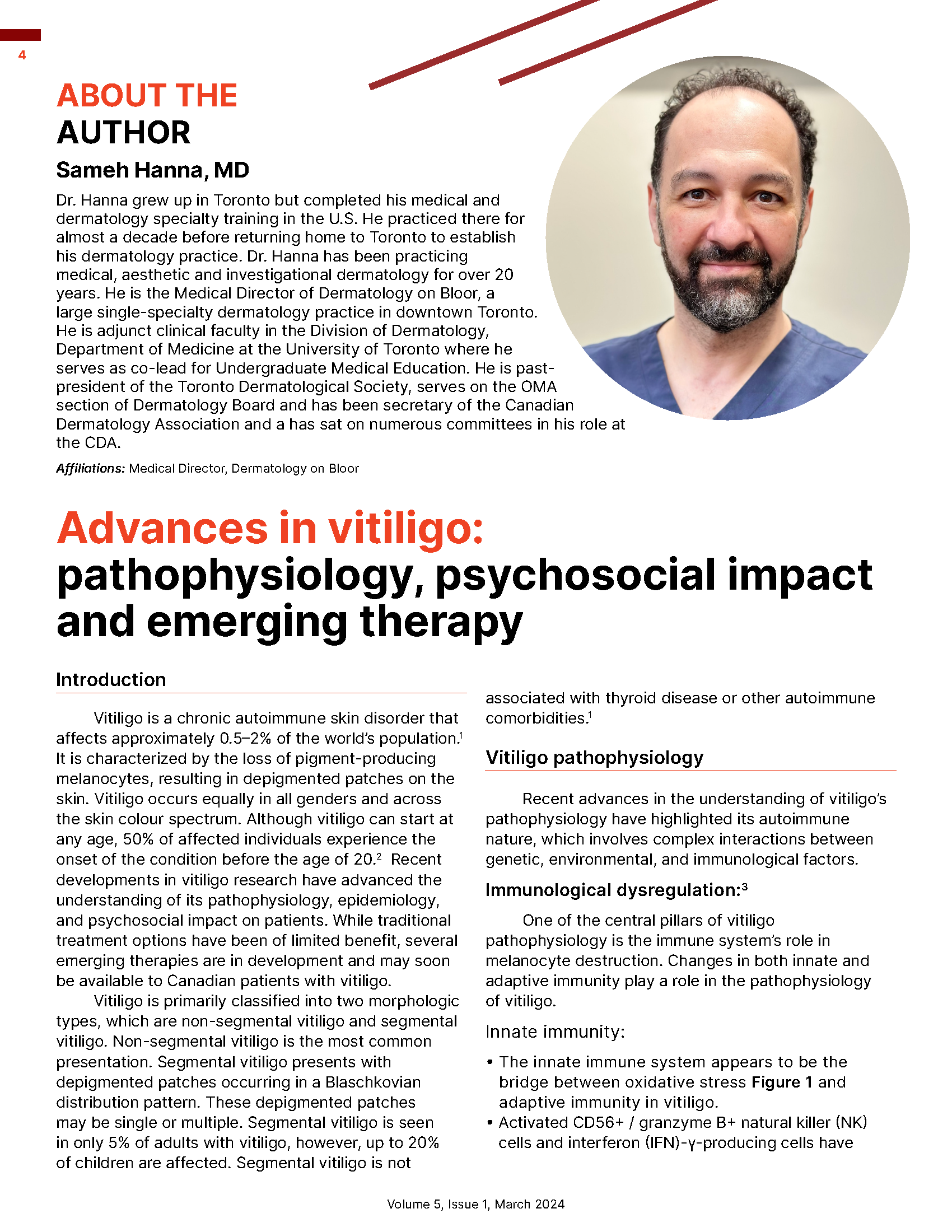Advances in Vitiligo: Pathophysiology, Psychosocial Impact and Emerging Therapy
Abstract
Vitiligo is a chronic autoimmune skin disorder that affects approximately 0.5–2% of the world’s population. It is characterized by the loss of pigment-producing melanocytes, resulting in depigmented patches on the skin. Vitiligo occurs equally in all genders and across the skin colour spectrum. Although vitiligo can start at any age, 50% of affected individuals experience the onset of the condition before the age of 20. Recent developments in vitiligo research have advanced the understanding of its pathophysiology, epidemiology, and psychosocial impact on patients. While traditional treatment options have been of limited benefit, several emerging therapies are in development and may soon be available to Canadian patients with vitiligo.
References
Bergqvist C, Ezzedine K. Vitiligo: A Review. Dermatology. 2020;236(6):571-592. doi:10.1159/000506103
Whitton ME, Ashcroft DM, Barrett CW, Gonzalez U. Interventions for vitiligo. Cochrane Database Syst Rev. 2006;1:CD003263. doi:10.1002/14651858
Faraj S, Kemp EH, Gawkrodger DJ. Patho-immunological mechanisms of vitiligo: the role of the innate and adaptive immunities and environmental stress factors. Clin Exp Immunol. 2022;207(1):27-43. doi:10.1093/cei/uxab002
Marchioro HZ, Silva de Castro CC, Fava VM, Sakiyama PH, Dellatorre G, Miot HA. Update on the pathogenesis of vitiligo. An Bras Dermatol. 2022;97(4):478-490. doi: 10.1016/j.abd.2021.09.008
Kaushik H, Kumar V, Parsad D. Mitochondria–melanocyte cellular interactions: an emerging mechanism of vitiligo pathogenesis. J Eur Acad Dermatol Venereol. 2023;37(11):2196-2207. doi: 10.1111/jdv.19019
Ongenae K, Beelaert L, van Geel N, Naeyaert JM. Psychosocial effects of vitiligo. J Eur Acad Dermatol Venereol. 2006;20(1):1-8. doi: 10.1111/j.1468- 3083.2005.01369.x 1
Ezzedine K, Eleftheriadou V, Jones H, Bibeau K, Kuo FI, Sturm D, et al. Psychosocial effects of vitiligo: a systematic literature review. Am J Clin Dermatol. 2021;22(6):757-774. doi:10.1007/s40257-021-00631-6
Patel KR, Singam V, Rastogi S, Lee HH, Silverberg NB, Silverberg JI. Association of vitiligo with hospitalization for mental health disorders in US adults. J Eur Acad Dermatol Venereol. 2019;33(1):191-197. doi:10.1111/jdv.15255
Padmakar S, Murti K, Pandey K, Kumari S, Kumar R, Ali Siddiqui N, et al. Suicidal ideation associated with vitiligo - a systematic review of prevalence and assessment. Clinical Epidemiology and Global Health. 2022;17:101140. doi:10.1016/j.cegh.2022.101140
Vallerand IA, Lewinson RT, Parsons LM, Hardin J, Haber RM, Lowerison MW, et al. Vitiligo and major depressive disorder: a bidirectional population-based cohort study. J Am Acad Dermatol. 2019;80(5):1371-1379. doi:10.1016/j. jaad.2018.11.047
Shourick J, Ahmed M, Seneschal J, Passeron T, Andreux N, Qureshi A, et al. Development of a shared decision-making tool in vitiligo: an international study [published correction appears in Br J Dermatol. 2022 Jan;186(1):200]. Br J Dermatol. 2021;185(4):787-796. doi:10.1111/bjd.20137
Speeckaert R, Taïeb A, Ezzedine K, Lim HW, Pandya AG, Passeron T, et al. Worldwide expert recommendations for the diagnosis and management of vitiligo: position statement from the International Vitiligo Task Force Part 1: towards a new management algorithm. J Eur Acad Derm Venereol. 37(11), 2173-2184. doi: 10.1111/jdv.19451
Seneschal J, Speeckaert R, Taïeb A, Wolkerstorfer A, Passeron T, Pandya AG, et al. Worldwide expert recommendations for the diagnosis and management of vitiligo: position statement from the International Vitiligo Task Force—Part 2: specific treatment recommendations. J Eur Acad Derm Venereol. 37(11), 2185-2195. doi: 10.1111/ jdv.19450
Eleftheriadou V, Atkar R, Batchelor J, McDonald B, Novakovic L, Patel JV, et al. British Association of Dermatologists guidelines for the management of people with vitiligo 2021. Br J Dermatol.186(1):18-29. doi: 10.1111/bjd.20596
Moghadam PM, Rasouli SR, Gheybi F, Karimi E, Sahebkar AH. A comprehensive review on present and future of pharmacotherapy of vitiligo disease and potential therapeutic strategies. Phytomedicine Plus. 2023;3(2):100437. https://doi.org/10.1016/j. phyplu.2023.100437
Wolkerstorfer A. Efficacy of prolonged ruxolitinib cream treatment for vitiligo among patients with limited or no initial response at 6 months. Oral Presentation, Late Breaking News EADV Congress, Oct 13, 2023, Berlin, Germany
Ezzedine K. Efficacy and safety of povorcitinib for extensive vitiligo: 52-week results from a double-blinded, placebocontrolled, dose-ranging phase 2b study. Oral Presentation, Late Breaking News EADV Congress, Oct 13, 2023, Berlin, Germany
Su X, Luo R, Ruan S, et al. Efficacy and tolerability of oral upadacitinib monotherapy in patients with recalcitrant vitiligo. J Am Acad Dermatol. 2023;89(6):1257-1259. doi:10.1016/j.jaad.2023.07.1016
Ezzedine K, Peeva E, Yamaguchi Y, Cox LA, Banerjee A, Han G, et al. Efficacy and safety of oral ritlecitinib for the treatment of active nonsegmental vitiligo: a randomized phase 2b clinical trial [published correction appears in J Am Acad Dermatol. 2023 Sep;89(3):639]. J Am Acad Dermatol. 2023;88(2):395-403. doi:10.1016/j.jaad.2022.11.005
Seneschal J. Efficacy and safety of the combination of oral baricitinib and NB-UVB for the treatment of active vitiligo: results from a randomized, double-blind, phase 2 proof of concept study. Oral Presentation, Late Breaking News EADV Congress, Oct 13, 2023, Berlin, Germany
Feng Y, Lu Y. Advances in vitiligo: update on therapeutic targets. Front Immunol. 2022;13:986918. doi:10.3389/ fimmu.2022.986918


